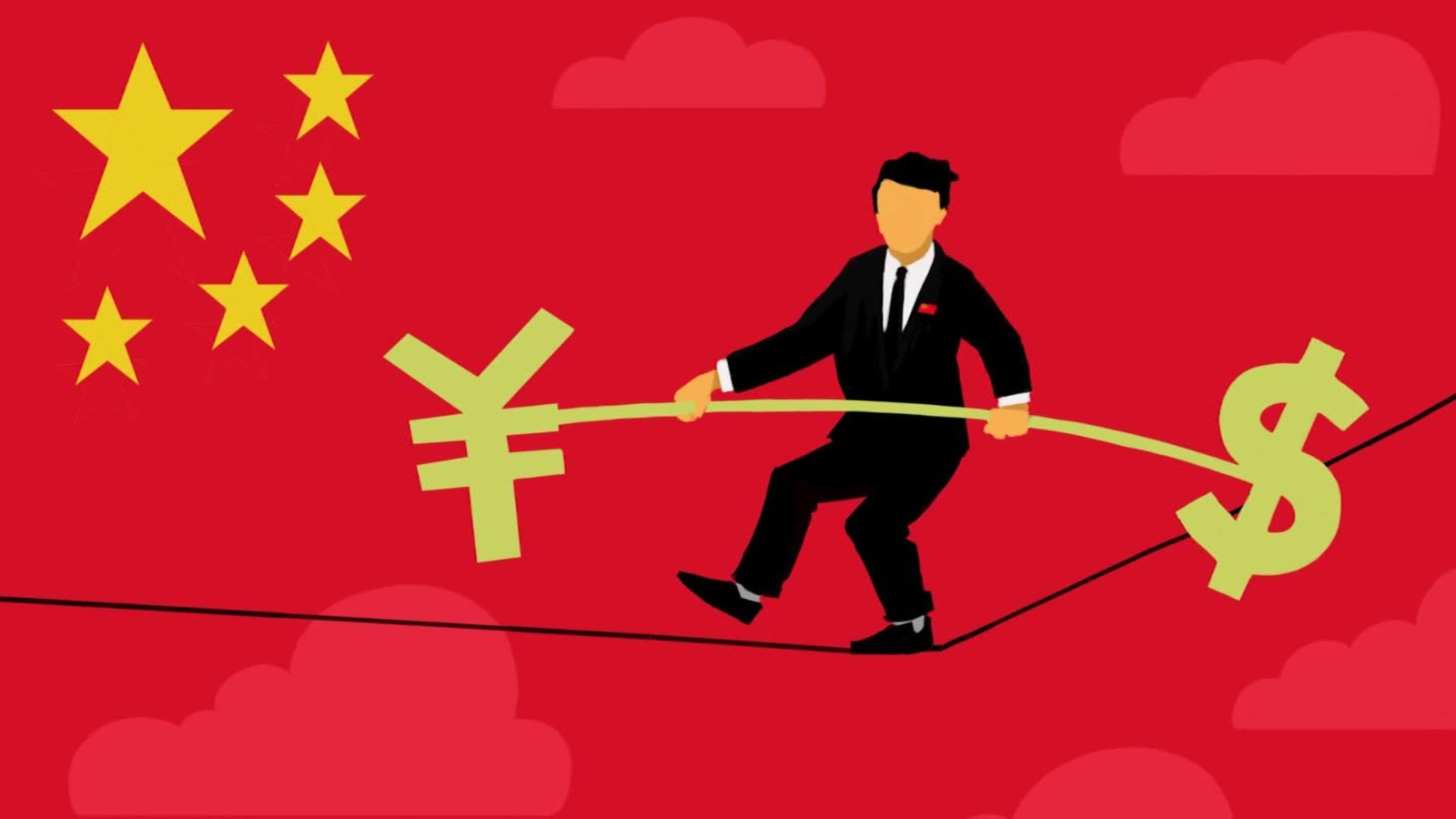China’s Industrial Profits Decline Furthering Deepening Economic Concerns
China's industrial firms have experienced a continued decline in profits, signalling a challenging economic landscape characterized by softening demand and shrinking margins. The double-digit decline in annual profits during the first five months, coupled with contractions in various sectors and economic indicators, emphasizes the need for additional policy support to revive the stuttering post-COVID economic recovery.

China, the world’s second-largest economy, is grappling with a significant slowdown in its industrial sector. Annual profits at China’s industrial firms have experienced a double-digit decline in the first five months of the year. Softening demand has squeezed margins, leading to an 18.8% year-on-year slump in profits, adding to concerns about the economy’s overall performance.
The National Bureau of Statistics (NBS) data reveals that once considered the global manufacturing hub, China’s manufacturing sector experienced feeble growth in industrial output.
In 2022, industrial output grew by a mere 3.6% year-on-year, with December witnessing a further decline to 1.3%. The slowdown can be attributed to anti-virus measures in major manufacturing hubs like Guangzhou and Zhengzhou, as well as the weight of the property crisis and slowing exports. Notably, profits fell for 21 out of 41 major industrial sectors, with the ferrous metals smelting and pressing industry experiencing the steepest decline at 94.5%.
While there is some hope for a turnaround, with the automotive sector witnessing a doubling in year-on-year profits in May, the overall recovery remains hindered by insufficient domestic demand and a complicated external environment.
NBS statistician Sun Xiao suggests that the foundation for a revival in industrial profits is still unstable, impacting foreign firms (with a 13.6% decline in earnings) and private-sector companies (with a 21.3% slide) during January-May.
Among the major industrial sectors, profits have declined for 24 out of 41, with the petroleum, coal, and fuel processing industry experiencing the most significant slump at 92.8%. This worrisome trend has prompted leading global agencies like S&P Global and Goldman Sachs to revise their China growth forecasts, given the patchy recovery and softening demand in domestic and overseas markets.

China’s Falling Profits
The decline in industrial profits is indicative of an economy losing momentum across various sectors. In addition to the drop in profits, May witnessed declines in retail sales, exports, and property investment. Furthermore, the youth jobless rate has reached a troubling high of 20.8%. These factors underscore the sustained difficulties faced by businesses in their operations.
The struggles faced by corporations call for additional policy measures to support them. Policymakers are expected to introduce support measures to stabilize the economy, especially in the face of domestic pressures and weakening demand in overseas markets.
Recently, China reduced its key lending benchmarks for the first time in 10 months and announced a 520 billion yuan package of purchase tax breaks on new-energy vehicles until the end of 2027.
Premier Li Qiang has emphasized the implementation of effective policy measures to expand domestic demand, aiming for higher economic growth in the second quarter and achieving the growth target of around 5% in 2023.
The decline in industrial profits in China has been staggering. Year-on-year, profits have contracted by 18.8% in the first five months, following a 20.6% decline in January-April. The negative trend is evident across various sectors, including retail sales, exports, and property investment.
Furthermore, the youth jobless rate has reached a distressing high of 20.8%. These figures indicate that the Chinese economy is losing steam on multiple fronts, presenting formidable challenges for businesses.
Wu Chaoming, the deputy director of the Chasing International Economic Institute, notes that the sluggish recovery in industrial profits underscores the sustained difficulties faced by businesses in China. This situation reinforces the need for additional policy measures to support struggling companies and mitigate the impact of the economic slowdown.

However, some glimmers of hope can be found within the auto manufacturing sector, which witnessed a doubling of year-on-year profits in May. It is worth mentioning that this improvement partially reflects the poor performance of the previous year when COVID-19 restrictions severely affected businesses.
NBS statistician Sun Xiao emphasizes that while external conditions are becoming increasingly complicated and severe, domestic demand still remains insufficient to drive a robust industrial profit recovery. This underscores the need for solid foundations to revive industrial profits in China.
The data breakdown reveals a decline in earnings for foreign firms by 13.6% during the January-May period, while private-sector companies experienced a significant 21.3% slide. Of the 41 major industrial sectors, 24 reported a decline in profits, with the petroleum, coal, and fuel processing industry suffering the most significant slump at 92.8%.
The patchy recovery of the Chinese economy has prompted global agencies, including S&P Global and Goldman Sachs, to revise their growth forecasts for China this year. Economists widely expect policymakers to implement additional support measures to stabilize the economy, as it faces both domestic pressures and softening demand in international markets.
In recent weeks, China has taken steps to bolster its faltering rebound, including cutting key lending benchmarks for the first time in 10 months and introducing a 520 billion yuan package of purchase tax breaks on new-energy vehicles until the end of 2027.
Speaking at the Summer Davos Forum, Premier Li Qiang pledged to roll out more effective policy measures to expand domestic demand. He expressed optimism that China’s second-quarter economic growth would surpass that of the first quarter, and the country remains on track to achieve its 2023 growth target of approximately 5%.
However, given concerns about local government debt and other long-term risks, the Chinese government remains cautious in its approach to reviving the economy. Industrial profit data encompasses firms with annual revenues of at least 20 million yuan ($2.77 million) from their primary operations. The release of China’s second-quarter GDP growth data in mid-July will shed further light on the economic outlook.

However, the Chinese government remains cautious about reviving the economy because of concerns over local government debt and other long-term risks, yet the slowdown in China’s industrial sector and its broader economic implications extend beyond the country’s borders.
At the World Economic Forum, Liu He, the vice-premier of the People’s Republic of China, addressed the concerns and challenges facing China and the global economy. He stressed for the need for cooperation in a fragmented world, given the unexpected events and deep changes witnessed in the world’s political and economic landscape over the past five years.
According to Kim Byung-yeon, an economics professor at Seoul National University, China’s economy is slipping into the middle-income trap, with productivity experiencing a sharp decline since 2014. China’s previous rapid growth was primarily driven by extensive investments in infrastructure, such as factories, housing, and roads, rather than structural reforms and innovation; however, this unsustainable growth model has reached its limits.
The decline in China’s GDP growth in 2022 can be attributed to several factors, including periodic lockdowns due to the strict “Zero Covid” policy, the government’s crackdown on large industrial firms, and the lingering real estate crisis. Industrial output recorded feeble growth, further exacerbated by the rebound in COVID outbreaks and lacklustre demand in November. Many Chinese companies are also facing sanctions from Western countries, particularly in the United States, over data security and patent infringement concerns.
Global Concerns
The slowdown in China’s economic growth has far-reaching implications for the global economy. Liu He, the vice-premier of the People’s Republic of China, articulated the concerns and challenges facing China during the World Economic Forum at Davos 2023.
He highlighted the impact of unexpected events and profound changes in the world’s political and economic landscape. China’s GDP growth in 2022 was slightly lower than the forecasts published by the International Monetary Fund (IMF) in October of the same year. Observers have been discussing China falling into the middle-income trap as it struggles to maintain sustained higher growth rates recorded in previous decades.
According to experts, China’s long-term growth rate is dependent on productivity, which has sharply declined in recent years. The country’s previous fast growth relied heavily on infrastructure investment rather than structural reform and innovation. Extensive growth driven by capital and labour input is not sustainable in the long run. The sluggish industrial growth can be attributed to various factors, including periodic lockdowns due to the “Zero Covid” policy, the government’s crackdown on large industrial firms, and the ongoing real estate crisis.
As Chinese companies face additional challenges due to Western sanctions, particularly from the United States, these sanctions primarily target Chinese tech companies accused of breaching data security and intellectual property theft.
The Last Bit, China’s industrial sector, is facing significant challenges, with a sharp decline in profits and a broader economic slowdown. The government has stabilized the economy and stimulated domestic demand through policy measures and tax breaks.
However, concerns over debt levels and long-term risks remain, casting a shadow over the prospects of a robust recovery. The implications of China’s economic downturn extend beyond its borders, posing risks to the global economy and potentially hindering the fight against climate change. As the world’s second-largest economy grapples with these challenges, international cooperation becomes crucial in navigating the fragmented global landscape and seeking sustainable solutions for economic growth.




